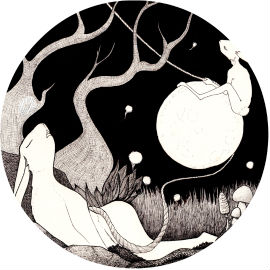Today’s little entry in the cabinet of curiosities comes from the royal palace in Amsterdam.
The palace squats at the edge of the Dam – the large central plein of Amsterdam. It was built in the mid-seventeenth century as a town hall, and its history as a centre of bureaucracy is reflected in the building’s history, whose many rooms – while converted into the living quarters and reception rooms of a palace by King Louis Napoleon in the early 1800s – are still named for their original functions. The enormous ‘ballroom’ style space is the Citizens’ Hall, and the rooms surrounding the hall are named, for example, the burgomaster’s chambers, the magistrates court, the chamber of the commissioner for petty affairs, the bankruptcy office*, and so on.

citizens’ hall
My favourite room is the Weeskammer, or the orphan masters’ room. This room was occupied by the person in charge of the physical, economic, social and spiritual wellbeing of any Dutch minor who had lost one or both parents. I love that this office was considered so essential to the economic and political health of the nation that an office was dedicated to it in the town hall. It is an intriguing early example of the Dutch emphasis on equality and the provision of care for all of the members of its society. The orphan master’s key role was to prevent the wealth of orphans from being taken from them by dishonourable members of their family. The orphan master’s chambers were converted into part of the royal family’s private chambers by King Louis in the early 1800s, and the decorations in the room reflect his passion for Empire Style furnishings and upholstery.

The orphan masters’ chamber
The other area of the palace that fascinated me is the tribunal (vierschaar). This is a marble room on the ground floor, decorated with grim sculptures of snakes and skulls, thorned plants and blades. There are four female statues on one wall, and between them are three marble friezes depicting, from left to right:
- The punishment of Zaleucus’ son. Zaleucus was a lawgiver who decreed that the punishment for adultery would be to have your eyes gouged out. When his son was found guilty of this crime, Zaleucus decreed that his son would lose one eye, and he himself would sacrifice one eye. The audio guide (in English) states that the crime was rape, but perhaps this is just a translation error.
- The judgement of Solomon. This story is, I think, far more widely known in the contemporary English-speaking world. The frieze shows two women standing before Solomon. They have come to seek his decision because both claim to be the child’s mother. Solomon order the child cut in half, and the woman who cries out that she will give the child up rather than see him harmed is awarded custody on the presumption that this proves she is his true mother.
- The final frieze shows the execution of the sons of Lucius Junius Brutus. Brutus was another lawgiver whose sons broke the law for which he had decreed the standard punishment. In this case, his sons were found guilty of treason – of plotting against Rome.

The tribunal
All of these grim and violent stories reflect the purpose of the chamber. This is where death sentences were publicly pronounced after they had been determined in the chamber of justice, which is immediately above the tribunal, and has a window through which the burgomasters can look down into the tribunal and comment on the proceedings.
Interestingly, the internal balcony from which the burgomasters could look down into the tribunal is also the site of the windows that open onto the balcony King Louis Napoleon had added to the palace during his reign. This is where members of the royal family appear to the public on special occasions, such as weddings and coronations. It is sobering to consider that the come out onto that balcony to wave and smile from a hallway that also looks down into the cold, forbidding chamber where the darkest, most severe punishments of the law were effected.

Crown Prince Willem-Alexander and Argentinian-born Máxima Zorreguieta appear on the balcony on their wedding day: 2nd February, 2002.
*One of Holland’s most famous bankrupts was reconciled in this room – that of the painter Rembrandt van Rijn.

No Comments